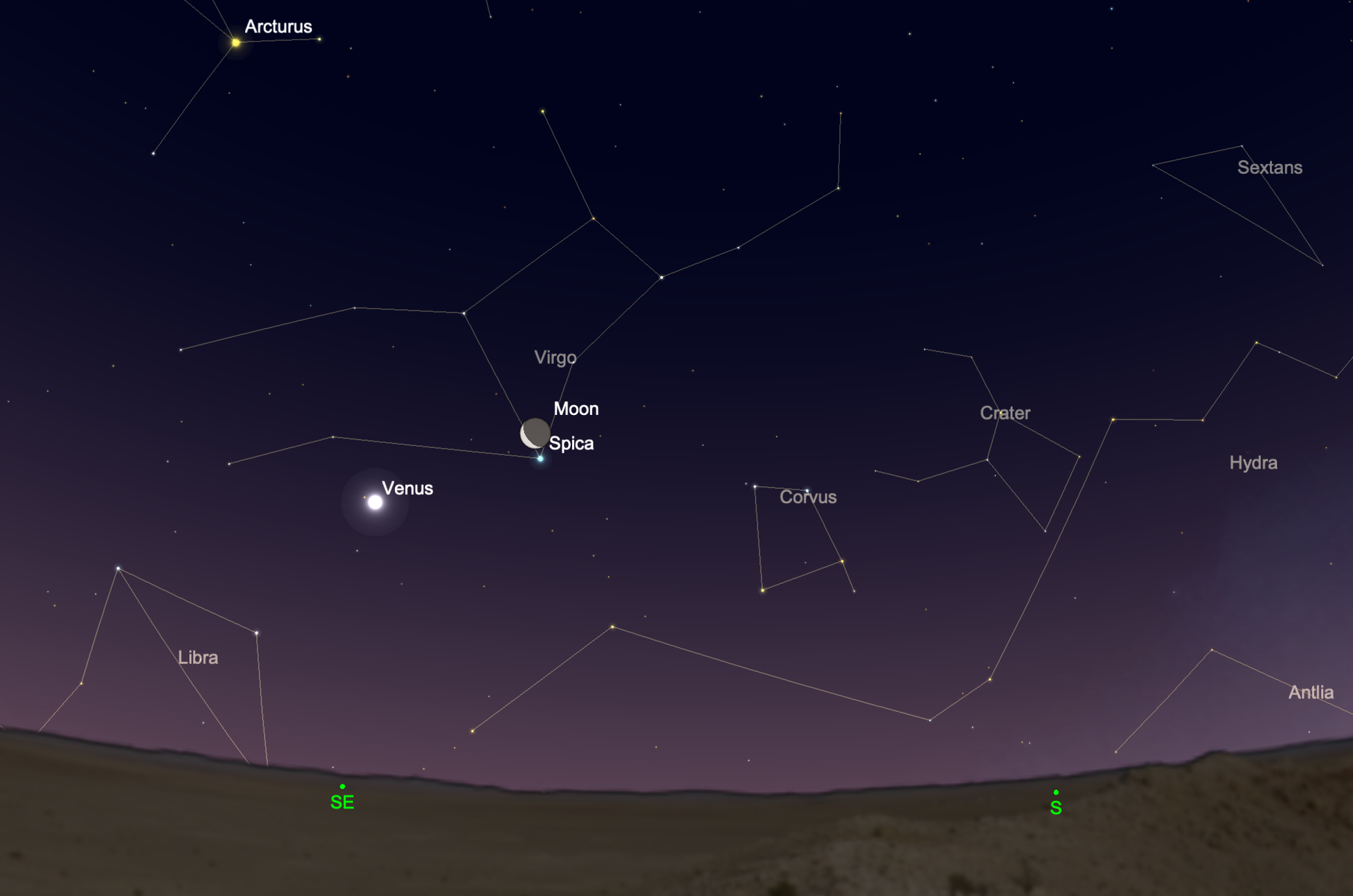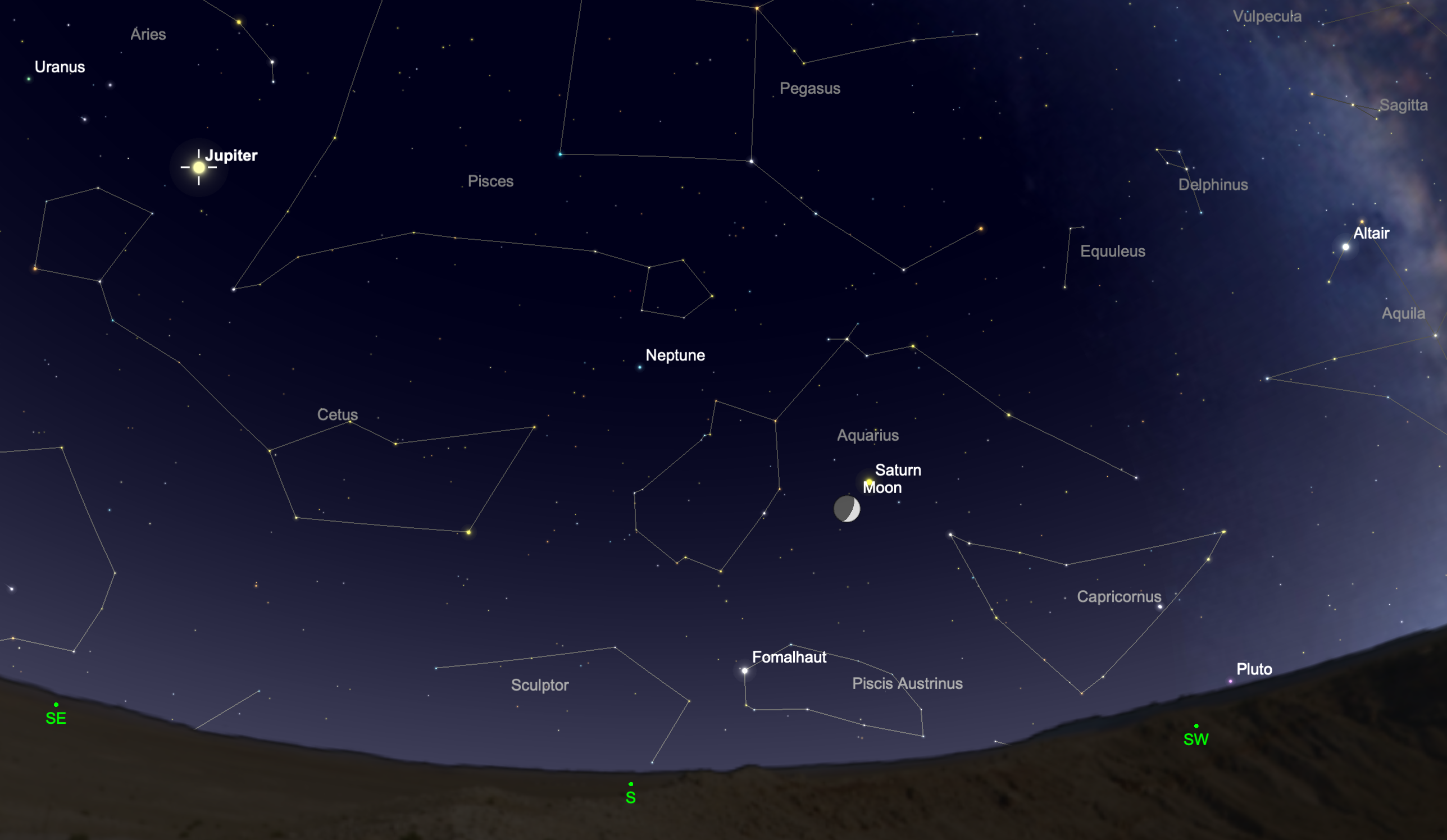As 2023 winds down, Saturn lingers in the western sky after sunset while Jupiter remains big and bright along the northern ecliptic, plenty big enough for fruitful telescopic observation. Venus remains bright in the early-morning sky in the southeast. It’s a great year for the Geminid meteor shower as the Moon stays out of the way at mid-month. And the seasons change as the Sun reaches its most southerly point on the ecliptic. Here’s what to see in the night sky in this month…
1 December 2023. Venus, making a fine showing as the ‘Morning Star’, lies a little less than 5o northeast of Spica in Virgo in the early morning sky. Venus is now receding from Earth and slowly growing smaller and fainter, but it still shines at a very bright magnitude -4.2. In a telescope, the planet appears gibbous with a disk about 17” across.
3 Dec. The waning gibbous Moon lies less than 5o from the bright star Regulus in Leo. The pair lie nearly overhead in the northern hemisphere as dawn arrives. This rendezvous repeats itself on Dec. 31.
5 Dec. Last Quarter Moon, 05:49 UT

8 Dec. Spica and Venus remain near each other in the southeastern morning sky, and the waning crescent Moon joins the show today as it lies about 3o north of Spica. The pair present a lovely view in binoculars.
9 Dec. In perhaps the best conjunction this month, the thin Moon and Venus pass within a few degrees of each other in the southeastern early-morning sky.
11-12 Dec. A rare and unusual event occurs tonight as the faint 14th-magnitude asteroid 319 Leona passes briefly in front of Betelgeuse! Those lucky enough to see this event – and it may only be a very few – may see the star wink out (or at least decrease significantly in brightness) for several seconds. Both the tiny asteroid (diameter about 50km to 80km) and immense Betelgeuse both subtend a nearly equal size of 50 milliarcseconds on the sky, but there’s considerable uncertainty about the asteroid’s size. More details on visibility and timing of the event at this link. Expected visibility is in a narrow band across southern Florida, the Atlantic Ocean, southern Spain, Italy, and Turkey.
12 Dec. New Moon, 23:32 UT
13-14 Dec. The usually reliable Geminid meteor shower peaks in the late hours of December 13 and into the early morning of the 14th. The Moon is well out of the way this year which makes for the best possible viewing. Look for Geminids late in the evening and after midnight. They can appear anywhere in the sky and trace their path back to a point near the star Castor in the constellation Gemini. Also, try looking after dark on the 13th for a few brighter Geminids that may enter the atmosphere at a shallow angle and burn slowly across the sky. The meteor shower happens on this date each year as the Earth passes through a stream of debris from the asteroid 3200 Phaethon, an Apollo asteroid discovered in 1983.

17 Dec. The Moon returns to the evening sky and today its crescent lies about 3o southeast of Saturn in the southwestern sky. Saturn is moving away from Earth and lies about ten astronomical units distant. It shines in Aquarius in the southwest after sunset all month at magnitude +0.9 with a disk about 17” across.
19 Dec. First Quarter Moon, 18:38 UT
21 Dec. The waxing gibbous Moon sits about 6o southwest of fat and bright Jupiter. About six weeks past opposition, Jupiter still shines in Aries at a brilliant magnitude -2.8 with a disk about 48” across. It’s a great time to observe the continuously changing face of the planet and its four bright moons with a good telescope.
22 Dec. The December solstice arrives at 03:27 UT as the Sun reaches its southernmost point on the ecliptic in the constellation Sagittarius. This marks the shortest day and the beginning of winter in the northern hemisphere and the longest day and beginning of summer in the southern hemisphere.
27 Dec. Full Moon, 00:33 UT
29 Dec. The fat gibbous Moon, just past full, lies in the constellation Cancer about 3o west of the Beehive star cluster (M44).
